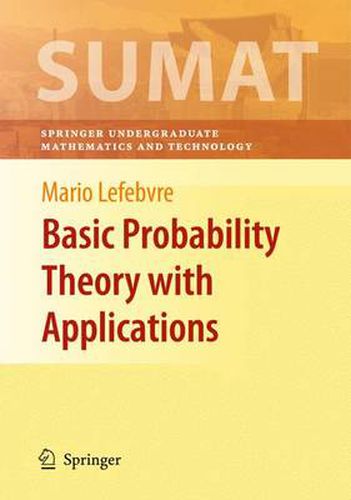Readings Newsletter
Become a Readings Member to make your shopping experience even easier.
Sign in or sign up for free!
You’re not far away from qualifying for FREE standard shipping within Australia
You’ve qualified for FREE standard shipping within Australia
The cart is loading…






This title is printed to order. This book may have been self-published. If so, we cannot guarantee the quality of the content. In the main most books will have gone through the editing process however some may not. We therefore suggest that you be aware of this before ordering this book. If in doubt check either the author or publisher’s details as we are unable to accept any returns unless they are faulty. Please contact us if you have any questions.
The main intended audience for this book is undergraduate students in pure and applied sciences, especially those in engineering. Chapters 2 to 4 cover the probability theory they generally need in their training. Although the treatment of the subject is surely su?cient for non-mathematicians, I intentionally avoided getting too much into detail. For instance, topics such as mixed type random variables and the Dirac delta function are only brie?y mentioned. Courses on probability theory are often considered di?cult. However, after having taught this subject for many years, I have come to the conclusion that one of the biggest problems that the students face when they try to learn probability theory, particularly nowadays, is their de?ciencies in basic di?erential and integral calculus. Integration by parts, for example, is often already forgotten by the students when they take a course on probability. For this reason, I have decided to write a chapter reviewing the basic elements of di?erential calculus. Even though this chapter might not be covered in class, the students can refer to it when needed. In this chapter, an e?ort was made to give the readers a good idea of the use in probability theory of the concepts they should already know. Chapter 2 presents the main results of what is known as elementary probability, including Bayes’ rule and elements of combinatorial analysis.
$9.00 standard shipping within Australia
FREE standard shipping within Australia for orders over $100.00
Express & International shipping calculated at checkout
This title is printed to order. This book may have been self-published. If so, we cannot guarantee the quality of the content. In the main most books will have gone through the editing process however some may not. We therefore suggest that you be aware of this before ordering this book. If in doubt check either the author or publisher’s details as we are unable to accept any returns unless they are faulty. Please contact us if you have any questions.
The main intended audience for this book is undergraduate students in pure and applied sciences, especially those in engineering. Chapters 2 to 4 cover the probability theory they generally need in their training. Although the treatment of the subject is surely su?cient for non-mathematicians, I intentionally avoided getting too much into detail. For instance, topics such as mixed type random variables and the Dirac delta function are only brie?y mentioned. Courses on probability theory are often considered di?cult. However, after having taught this subject for many years, I have come to the conclusion that one of the biggest problems that the students face when they try to learn probability theory, particularly nowadays, is their de?ciencies in basic di?erential and integral calculus. Integration by parts, for example, is often already forgotten by the students when they take a course on probability. For this reason, I have decided to write a chapter reviewing the basic elements of di?erential calculus. Even though this chapter might not be covered in class, the students can refer to it when needed. In this chapter, an e?ort was made to give the readers a good idea of the use in probability theory of the concepts they should already know. Chapter 2 presents the main results of what is known as elementary probability, including Bayes’ rule and elements of combinatorial analysis.